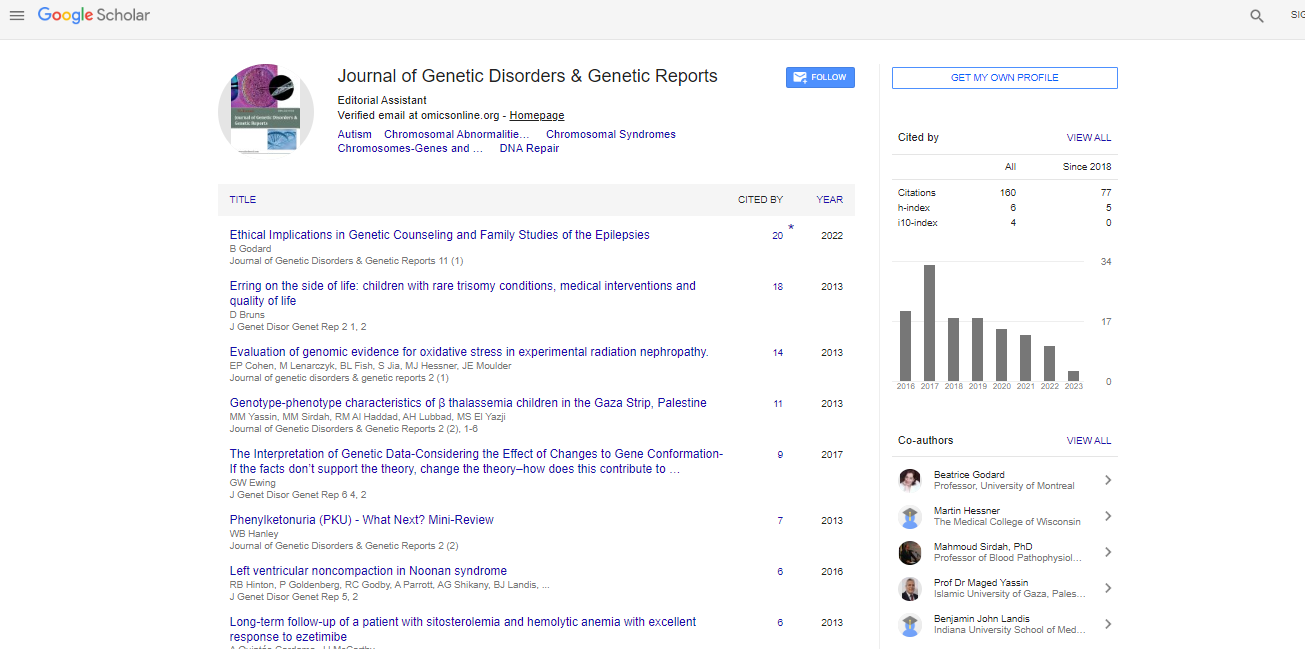Editorial, J Genet Disor Genet Rep Vol: 1 Issue: 1
Translational Research to Uncover Diagnostic & Therapeutic Gene Targets Emerging in a Genomic Era: from Bench to Bedside
| Blum K1-7,9*, Giordano J2, Borsten J3, Downs BW4, Hauser M5, Simpatico T6, Lohmann R7, Braverman ER8 and Barh D9 |
| 1Department of Psychiatry, University of Florida, College of Medicine& McKnight Brain Institute, Gainesville, Florida, USA |
| 2Department of Holistic Medicine, G & G Holistic Addiction treatment Center, North Miami Beach, Florida, USA |
| 3Malibu Beach Recovery Center, Malibu Beach, California, USA |
| 4Department of Nutrigenomics, LifeGen, Inc., Austin, Texas, USA |
| 5Dominion Diagnostics, Inc. North Kingstown, Rhode Island, USA |
| 6Department of Psychiatry, University of Vermont, Burlington, Vermont, USA |
| 7Department of Clinical Neurology, Path Foundation NY, New York, New York, USA |
| 8Department of Neurological Surgery, Weil-Cornell College of Medicine, New York, USA |
| 9Center for Genomics and Applied Gene Technology, Institute of Integrative Omics and Applied Biotechnology (IIOAB), Nonakuri, Purba Medinipur, West Bengal, India |
| Corresponding author : Blum K Department of Psychiatry, University of Florida, College of Medicine & McKnight Brain Institute, Gainesville, Florida, USA Tel: 619- 890-2167 E-mail: drd2gene@gmail.com |
| Received: June 21, 2012 Accepted: June 22, 2012 Published: June 25, 2012 |
| Citation: Blum K, Giordano J, Borsten J, Downs BW, Hauser M, et al. (2012) Translational Research to Uncover Diagnostic & Therapeutic Gene Targets Emerging in a Genomic Era: from Bench to Bedside. J Genet Disor Genet Rep 1:1. doi:10.4172/2327-5790.1000e103 |
Abstract
Translational Research to Uncover Diagnostic & Therapeutic Gene Targets Emerging in a Genomic Era: from Bench to Bedside
Since the discovery of the double-helix in the 50’s until the recent mapping of the human genome, genetically -based medicine has held the promise of significantly impacting our daily lives. Interestingly, by 2003, there were 51 Nobel Prizes given for gene related studies. Scientific exploration is holding out the hope for the discovery of novel therapies that will diminish the devastation of genetically based diseases. It is well known that despite the fact that polymorphisms or gene variants account for a very low percentage (1%) of the Homo sapiens’s genome, diseases involving DNA have challenged the entire global scientific community since Adam bit the “forbidden apple” and indeed was “thrown out” of paradise.
| Since the discovery of the double-helix in the 50’s [1] until the recent mapping of the human genome, genetically -based medicine has held the promise of significantly impacting our daily lives. Interestingly, by 2003, there were 51 Nobel Prizes given for gene related studies [2]. Scientific exploration is holding out the hope for the discovery of novel therapies that will diminish the devastation of genetically based diseases. It is well known that despite the fact that polymorphisms or gene variants account for a very low percentage (1%) of the Homo sapiens’s genome, diseases involving DNA have challenged the entire global scientific community since Adam bit the “forbidden apple” and indeed was “thrown out” of paradise. Seriously, before the mapping of the genome and the introduction of amazing neuroimaging tools such Positron Emission Topography (PET), Functional Magnetic Imaging (fMRI) and SPEC, scientific researchers were incapable of comprehending the true relationship between nature vs nurture. In the age-old debate of nature vs. nurture, Lemonick an M.I.T. professor says our genes don’t get enough respect [3]. | |
| While many are not excited about the progress to date in terms of finding specific gene polymorphisms associated with genetic diseases by using candidate gene, rare gene and or GWAS analysis using sophisticated analytical techniques like arrays and large polygenic SNP identification [4], we are making progress in terms of evolutionary genetics. Progress to date has been slow and in a number of cases the incorporation of gene therapy, stem cell manipulation, gene repair involving sense and antisense applications among other novel and important emerging techniques has met with as yet unsolved technical issues. However, there are a number of examples of successful gene therapy applications in the current literature including gene repair for lung disease such as dissecting epigenetic silencing complexity in the mouse lung cancer suppressor gene cadm1 [5], umbilical cord stem cell transplantation for primary immunodeficiencies [6], microRNAS as cancer therapeutics [7], delivery of two-step transcription amplification exendin-4 plasmid system with arginine-grafted bioreducible polymer in type 2 diabetes [8] and including drug addiction involving the cDNA of the DRD2 gene [9]. | |
| This new journal of Genetic Diseases and Disease information will serve as an important reference source for new information ever expanding in this remarkable period known as the genomics era. Currently there are thousands of peer reviewed papers in the entire omics field and it is just the “tip of the iceberg”. Even in the world of psychiatric genetics we have seen the birth of a relatively new discipline. A walk in the past reveals an explosive academic thrust to evaluate the role of genetics in all psychiatric based diseases/disorders. Interestingly, the first confirmed paper ever published in the field of psychiatric genetics was in 1990 when Ernest P. Noble and one of us (KB) and our colleagues discovered the first association of the Dopamine D2 receptor gene polymorphism (A1 allele) with severe alcoholism [10,11]. In fact before this study other than one other non-confirmed study on associating the tyrosine hydroxylase gene in depressed Amish there was no psychiatric genetic discipline. In fact, when we proposed a Gordon Research conference for Psychiatric Genetics announced in Science Magazine in 1996 the conference was cancelled. We could not interest the needed 100 scientists across the globe to attend. However, since that time Psychiatric Genetics has emerged as an extremely important and active area of scientific exploration. There are major societies such as the “World Congress of Psychiatric Genetics” and the Society of “Behavioral Genetics” with associated peer-reviewed journals and thousands of members attending their respective annual conferences. To date just in the field of psychiatric genetics there are 12,378 articles listed in PUBMED (8/20/12). | |
| In one scenario it is noteworthy that this strategy may provide millions afflicted with a genetic disorder known as “Reward Deficiency Syndrome” (RDS), first coined by Blum et al. [14] RDS is defined by MSN (Microsoft Dictionary) as a brain reward genetic dissatisfaction or impairment that results in aberrant pleasure seeking behavior that includes drugs, food, sex, gaming/gambling and other behaviors. Currently there are thousands of studies that have unequivocally identified gene polymorphisms in many neurotransmitter (reward) genes (e.g. serotonin, opioid peptides, GABA, Dopamine, norepinephrine, acetycholine etc) associated with RDS. Studies have shown that evaluating a panel of certain reward genes not only associates with adolescent personality disorders [15] but also enables the stratification of genetic risk to RDS [12]. The latter panel is called the “Genetic Addiction Risk Score (GARS)”. Thus a potential diagnostic tool for the genetic disorder RDS. The use of this test as pointed out by others [16] would assist the medical community in identifying at risk individuals at a very early age. The second phase of the strategy could include a side effect free natural dopamine D2 agonist to proliferate compromised (carriers of the DRD2 A1 allele) density or number of dopamine D2 receptors. Importantly, our group may have found such a compound (KB220Z) as determined in many clinical trials (27 studies) including recent neuroimaging analysis. A review of these seminal studies reveal a number of positive findings including anti-craving, reduced AMA rates as well as anti-relapse effects [17-20]. | |
| Furthermore, the compound induces a regulation of the dysregulated activity in the pre-frontal cortex cingulate gyrus in abstinent alcoholics, heroin addicts by increasing alpha and low beta waves and activates nucleus accumbens dopaminergic pathways [21]. As part of a working therapeutic strategy involving treatment outcomes, we are also proposing that in the future, measurement of mRNA gene expression based on a number of known gene polymorphisms (as measured using GARS) along with advanced urine testing by using the “Comprehensive Analysis Reported Drug” (CARD) to determine treatment compliance to prescribed treatment medications and abstinence from drugs of abuse during treatment would assist the patient in the recovery process (reference Colliers Magazine). The incorporation of KB220Z, for example, along with both mRNA (to determine gene expression status) and CARD (to determine both compliance and abstinence) should provide appropriate therapy as well removing the guess work in terms of knowing positive/negative treatment outcomes. | |
| This strategy which could fit for other genetic diseases/syndromes makes good sense in face of a new definition of addiction as recently proposed by ASAM (American Association of Addiction Medicine) – Addiction is a brain disorder having reward circuitry impairments. Being cognizant that unlike other genetic disease victims of RDS may feel ashamed due to societal stigma and they rely heavily on a fellowship program with or without spirituality [22]. In fact, religious respondents were more likely to participate in 12-step groups and Women for Sobriety. Nonreligious respondents were significantly less likely to participate in 12-step groups. Religiosity had little impact on recovery participation but actually decreased participation in Secular Organizations for Sobriety. These results have important implications for treatment planning and matching individuals to appropriate support groups. In terms of genetics it is known that specific gene polymorphisms impact religiosity or spirituality [23]. | |
| This now takes on an important question which needs to be addressed by the entire RDS community- if RDS is a genetically induced disease that effects brain function then diagnosis should be genetically based in part- and the brain should be treated for genetically induced hypodopaminergic function. Unfortunately only a fraction of the total RDS treatment community (estimated to be over 12,000 facilities) utilizes a neuroscience based approach. It would be analogous to cardiovascular disease (known to be genetically influenced) whereby the clinical program does not address the heart [24] or treatment for breast cancer ignored targeting mutations of BRCA1 and BRCA2 genes [25]. | |
| With advent of an enormous interest in genetic information about diseases the scientific community will strive to understand the genetic underpinnings of the disease in question and utilize gene testing for appropriate diagnosis and therapeutic targeting of the root cause of dysfunction. In the RDS field utilizing a holistic approach including pharmaceuticals/nutraceuticals and many other modalities that increase dopamine function such as diet, yoga, meditation, exercise, talk and, music therapy coupled with other behavioral and physiological modalities [26-28] and of course the 12 step program to address the underlying genetic disease/syndrome. | |
| We now ask should a clinician or treatment program be held responsible (even in a legal way) for not appropriately diagnosing a genetic disease by analyzing known gene polymorphisms associated with the “disease” in question and where available therapeutically target the end organ. This is indeed an important legal and ethical question that must be addressed. | |
| We congratulate the editors of this new journal for their visionary perspective that links scientific studies with in-depth analysis of relationships of not only gene polymorphisms but important epigenetic effects [29], induced by environmental factors and addressing ethical issues in terms of providing disease information to the entire scientific community. Finally, articles accepted for publication will undoubtedly further our understanding of the role of genes in diseases/syndromes emphasizing novel translational research that will ultimately bridge the bench to the bedside. | |
Acknowledgement |
|
| The authors are grateful to Margaret A. Madigan for her excellent editoring of the entire manuscript. | |
Conflict of Interest |
|
| Kenneth Blum and B. William Downs own stock in LifeGen, Inc. the exclusive worldwide distributors of KB220Z.™ John Giordano and Joan Borsten and Dominion Diagnostics are LifeGen partners. | |
References |
|
|
 Spanish
Spanish  Chinese
Chinese  Russian
Russian  German
German  French
French  Japanese
Japanese  Portuguese
Portuguese  Hindi
Hindi 



